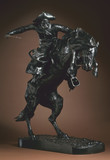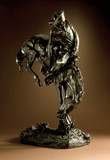Frederic Sackrider Remington achieved a classic status as the foremost artist of the American West. He was born in Canton, New York, but after the age of eleven was raised in nearby Ogdensburg. Deciding to become an artist, he enrolled in the Yale School of Fine Arts, where he studied drawing until the death of his father cut short his college career after a year and a half He worked at a number of jobs in Ogdensburg and Albany, made a brief trip to Montana Territory, and worked as a clerk in Albany. Coming into an inheritance at the age of twenty-one, he went to Kansas, purchased a sheep ranch, which he sold in less than a year, and then invested in a hardware store and later a saloon, both of which failed. While in Kansas City in 1884 he began to support himself with the sale of paintings locally and of illustrations to publishers in New York City. He traveled through New Mexico and Arizona Territories before moving in 1885 to New York, where he worked as an illustrator specializing in Western subjects. In 1886 he studied for one term at the Art Students League. He achieved success and wide reputation as an illustrator in just a few years. He also began to write about the West. In 1889 he was able to buy a large suburban house. Already an accomplished painter, the following year he had his first solo show of his paintings of life and adventure in the American West.
Remington frequently returned to the West to sketch and report, sometimes traveling with cavalry troops as he sought the flavor of the lives of the soldiers and cowboys. In 1892 he traveled to Europe and North Africa. He generally summered in the Adirondacks. In 1895, the same year that the first collection of his magazine articles was published, he began to work as a sculptor, attaining immediate acclaim. Remington visited Cuba in 1897 and as an illustrator and correspondent during the Spanish-American War. After 1900 he did much of his painting during summers on Inglenuek, a small island in the Saint Lawrence River near Ogdensburg. During this period he enjoyed even greater success and recognition. After 1905 he frequently abandoned the highly realistic, action, filled painting style that had won him this renown, preferring a softer, more atmospheric rendering of more imaginative themes. In 1909 he completed construction of a large house in Ridgefield, Connecticut. He died suddenly at the age of forty-eight following an unsuccessful appendectomy.
BIBLIOGRAPHY
Harold McCracken, Frederic Remington: Artist of the Old West (Philadelphia: Lippincott, 1947), with bibliographic checklist of Remingtoniana (including chronological list of works illustrated in periodicals and books) § Ben Merchant Vorphal, My Dear Wister! The Frederic Remington - Owen Wister Letters (Palo Alto, Calif.: American West, 1972) § Washington, D.C., Smithsonian Institution, National Museum of American Art, and others, Cast and Recast: The Sculpture of Frederic Remington, exh. cat., 1981, published by Smithsonian Institution Press, by Michael Edward Shapiro, with bibliography, lists of bronzes and Roman Bronze Works castings § Peggy Samuels and Harold Samuels, Frederic Remington: A Biography (1982; reprint, Austin: University of Texas Press, 1985), with bibliography § Michael Edward Shapiro and Peter H. Hassrick, Frederic Remington: The Masterworks (Saint Louis: Saint Louis Art Museum in conjunction with Buffalo Bill Historical Center, Cody, Wyo., and Harry N. Abrams, New York, 1988), with essays by David McCullough, Doreen Bolger Burke, and Joseph Seelye, lists of Henry-Bonnard Bronze Co. casts of The Bronco Buster and bronze edition sizes as of 1907, published in conjunction with an exhibition at the Saint Louis Art Museum and others, 1988-89.


